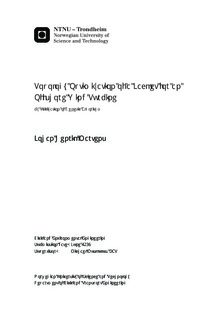Topology Optimization of a Jacket for an Offshore Wind Turbine: by Utilization of Genetic Algorithm
Master thesis
Permanent lenke
http://hdl.handle.net/11250/232903Utgivelsesdato
2014Metadata
Vis full innførselSamlinger
Sammendrag
The construction of offshore wind farms for electricity production has shown great promise. Both as a contributing element in mitigating the ongoing climate changes, and in lessening the global oil dependency. However, construction and operation cost is a limiting factor in utilization of offshore wind energy on a significant scale. The potential for cost reduction related to the support structure is high. In this thesis, a script was written to optimize the topology of a jacket support structure by utilizing genetic algorithm (GA).GA is a heuristic optimization method mimicking the natural process known as "survival of the fittest". The algorithm was implemented using a MATLAB script while dynamic structural response was analyzed by a specialized simulation tool, Fedem Windpower. The topology optimization took a ground structure approach by utilizing a master jacket model. Several variations of this master model were continuously customized by the MATLAB script. Models that failed either by yielding, by fatigue or by the Fedem solver crashing, were discarded from the optimization. Surviving designs were evaluated for fitness using a cost related function. The jacket designs with the highest fitness were most likely to pass their traits on to the next generation of designs. At the end of this iterative optimization loop, the jacket topology with the highest fitness was the winner.Several simple cubic jackets, and more complex 32 m high jackets, were optimized. As a reference, the resulting topologies were compared with a quick manual optimization of the same design domain. The quality of the automatically optimized designs were highly dependent on the complexity of the ground structure utilized. The designs produced by GA had a higher fitness, i.e. lower cost, than the manually optimized counterpart for the simple cubic jacket and vice versa for the complex jacket. A decent topology was not generated for the most complex case considered, in part due to lack of computational power. The optimization runs carried out in this thesis has shed light on the potential and the limitation of GA in general, and on the employed implementation in particular. Superior and more cost-efficient topologies can likely be designed by an extended implementation of GA in combination with manual optimization. Suggestions for further work is given.
